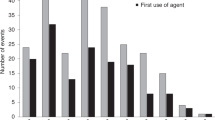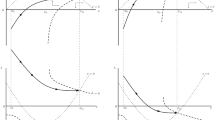Abstract
This paper studies how the strength of intellectual property rights (IPRs) affects investments in biological innovations when the value of an innovation is stochastically reduced to zero because of the evolution of pest resistance. We frame the problem as a research and development (R&D) investment game in a duopoly model of sequential innovation. We characterize the incentives to invest in R&D under two competing IPR regimes, which differ in their treatment of the follow-on innovations that become necessary because of pest adaptation. Depending on the magnitude of the R&D cost, ex ante firms might prefer an intellectual property regime with or without a “research exemption” provision. The study of the welfare function that also accounts for benefit spillovers to consumers—which is possible analytically under some parametric conditions, and numerically otherwise—shows that the ranking of the two IPR regimes depends critically on the extent of the R&D cost.
Similar content being viewed by others
References
Alix-Garcia J, Zilberman D (2005) The effect of market structure on pest resistance buildup. Working Paper, available at SSRN: http://ssrn.com/abstract=836164
Bessen J and Maskin E (2006). Sequential innovation, patents and imitation. Working Paper, Research on Innovation, Boston, MA
Brock WA and Xepapadeas A (2003). Valuing biodiversity from an economic perspective: a unified economic, ecological and genetic approach. Am Econ Rev 93(5): 1597–1614
Denicolò V (1999). The optimal life of a patent when the timing of innovation is stochastic. Int J Ind Organ 17: 488–501
Denicolò V (2000). Two-stage patent races and patent policy. RAND J Econ 31(3): 488–501
Fisher C and Laxminarayan R (2004). Keeping one row ahead of the bugs: the economics of pest resistance to transgenic crops. Resources 152: 5–8
Fisher C and Laxminarayan R (2005). Sequential development and exploitation of an exhaustible resource: do monopoly rights promote conservation?. J Environ Manage 49: 500–515
Fudenberg D and Tirole J (1991). Game theory. The MIT Press, Cambridge, MA
Fuglie K, Ballenger N, Day K, Klotz C, OllingerM, Reilly J, Vassavada U, Yee J (1996) Agricultural research and development: public and private investments under alternative markets and institutions. USDA/ERS, Agricultural Economics Report No. 735, Washington, DC
Goeschl T, Swanson T (2002a) On the economic limits to technological potential: will industry resolve the resistance problem? In: Swanson T (ed) The economics of managing biotechnologies Netherlands, Kluwer
Goeschl T, Swanson TM (2002b) Lost horizons: the non-cooperative management of an evolutionary biological system. Fondazione Eni Enrico Mattei, Nota di Lavoro, 89
Goeschl T, Swanson TM (2003a) On biology and technology: the economics of managing biotechnologies. FEEM Working Paper 42.03, Fondazione ENI Enrico Mattei
Goeschl T and Swanson TM (2003b). Pests, plagues and patents. J Eur Econ Assoc 1(2–3): 561–575
Green J and Scotchmer S (1995). On the division of profit in sequential innovation. RAND J Econ 6(1): 20–33
Hueth D and Regev D (1974). Optimal agricultural pest management with increasing pest resistance. Am J Agric Econ 56: 543–552
Hurley TM, Secchi S, Babcock B and Hellmich R (2002). Managing the risk of European corn borer resistance to Bt corn. Environ Resour Econ 22: 537–558
Janis MD and Kesan JP (2002). Intellectual property protection for plant innovation: unresolved issues after J.E.M. v. Pioneer. Nat Biotechnol 20: 1161–1164
Just RE, Alston JM, Zilberman D (eds) (2006). Regulating agricultural biotechnology: economics and policy. Springer, New York
Langinier C, Moschini G (2002) The economics of patents. In: Rothschild M, Newman S (eds) Intellectual property rights in animal breeding and genetics. CABI, Wallingford, Oxon, UK
Moschini G (2004). Intellectual property rights and the World Trade Organization: retrospect and prospects. In: Anania, G, Bohman, M, Carter, C and McCalla, A (eds) Agricultural policy reform and the WTO, pp. Edward Elgar Publishing, Aldershot UK
Moschini G, Yerokhin O (2006) Patents, research exemption, and the incentive for sequential innovation. Working Paper # 06019, Department of Economics, Iowa State University, Ames, Iowa
Noonan D (2002) An economic model of a genetic resistance commons: effects of market structure applied to biotechnology in agriculture. In: Laxminarayan R (ed) Battling resistance to antibiotics and pesticides: an economic approach. RFF Press, Washington, DC
O’Donoghue T (1998). A patentability requirement for sequential innovation. RAND J Econ 29(4): 654–679
Palumbi R (2001). Humans are world’s greatest evolutionary force. Science 293(5536): 1786–1790
Reinganum J (1989). The timing of innovation: research, development and diffusion. In: Schmalensee, R and Willig, RD (eds) Handbook of industrial organization, Vol. 1, pp. North-Holland, Amsterdam
Swanson T (ed) (2002). The economics of managing biotechnologies. Kluwer, Netherlands
UNCTAD (United Nations Conference on Trade and Development) (2006) Tracking the trend towards market concentration: the case of the agricultural input industry, UNCTAD/DITC/COM/2005/16
Wright BD and Pardey PG (2006). The evolving rights to intellectual property protection in the agricultural biosciences. Int J Technol Global 2: 12–29
Author information
Authors and Affiliations
Corresponding author
Rights and permissions
About this article
Cite this article
Yerokhin, O., Moschini, G. Intellectual Property Rights and Crop-Improving R&D under Adaptive Destruction. Environ Resource Econ 40, 53–72 (2008). https://doi.org/10.1007/s10640-007-9140-5
Received:
Accepted:
Published:
Issue Date:
DOI: https://doi.org/10.1007/s10640-007-9140-5
Keywords
- Biological resistance
- Intellectual property rights
- Markov perfect equilibrium
- Patents
- Research exemption
- R&D
- Sequential innovation




